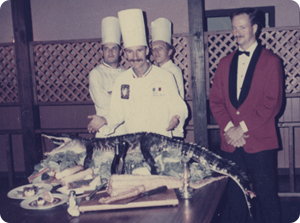
 � � |
|||
|
Chef Philippe on Marketing Alligator: Alligator as a restaurant menu item in Louisiana in 1985 The following is an excerpt from the upcoming book by Philippe Parola: My first experience with marketing exotic or nuisance game started in 1985 when I met the most characteristic individual of my life. Egon Klein was a true entrepreneur who moved to Louisiana in the mid-seventies to buy alligator skins from trappers to ship for tanning and processing in Italy. Egon was a native of Romania and spent several years of his childhood as a captive of the Nazi concentration camp during World War II. His I.D. tattoo on his wrist always reminded me that I'd better respect the hell out of this man. Egon's business started to decline in the late 70's because of the animal rights movement that started in Europe; when no one wanted to wear furs or skin goods from wild animals. One day during lunch hour Egon came to my restaurant, the "Chez Paris", with a little ice chest full of alligator meat. �Since alligator skin was losing its value and his enterprise was failing, Egon, with his strong Romanian accent asked me: "Chef, can you create alligator meat recipes so that I can sell the whole alligator instead of just the skin?" My answer to Egon was simple: "Come back tomorrow and I will have a few dishes for you to taste!" Egon was a former professional soccer player for Romania's national team and was always full of energy, and his attitude for business was always very positive. He and I were the perfect match to launch a campaign for Louisiana alligator meat. After creating dishes such as pre-cooked Smoked Alligator Loin and marinated tail meat for Alligator Beignet, we attended the Boston Seafood Show introducing samples of our new Louisiana exotic meat. The next year we attended SIAL, the international food exhibit, where for the first time Louisiana alligator meat was on an international market as a premier exotic delicacy. With lots of hard work and positive feedback, sales started pouring in. Since Egon was also involved in snail processing in his native Romania, I later traveled to Romania to help create pre-cooked value-added escargot for the European retail market -- one such famous recipe being Escargot Bourguignon with white wine, garlic, parsley and butter. � From another target aspect of his business, together Egon and I promoted Louisiana crawfish meat to the Swedish market. To everyone's surprise, Sweeds are the largest consumers of crawfish, perhaps in the world. Being very instrumental in developing recipe concepts for mass production and exportation of Louisiana Crawfish A La Nage for the Swedes, this classic recipe is cooked in dill broth. Egon was truly a father figure to me. Excerpt from upcoming book by Philippe Parola |
About the American Alligator: The American alligator is the largest reptile in North America and has ancestry as far back as 200 million years ago. The name alligator comes form �early Spanish explorers who saw the giant reptiles and called them "El legarto" or "big lizard". Louisiana has the highest alligator population reaching as high as 2 million. To help control this population, Louisiana has official alligator harvesting and ranching programs. The Louisiana alligator industry, through the sale of alligator skins, alligator�eggs, and alligator meat from the 150,000 alligators that are harvested annually, is a renewable natural resource that is worth U.S. $20 million per year.
More Information: Louisiana Alligator Advisory Council Official LDWF Alligator Hunting Website National Geotraphic: �Controlled Alligator |
||
 |
|||











